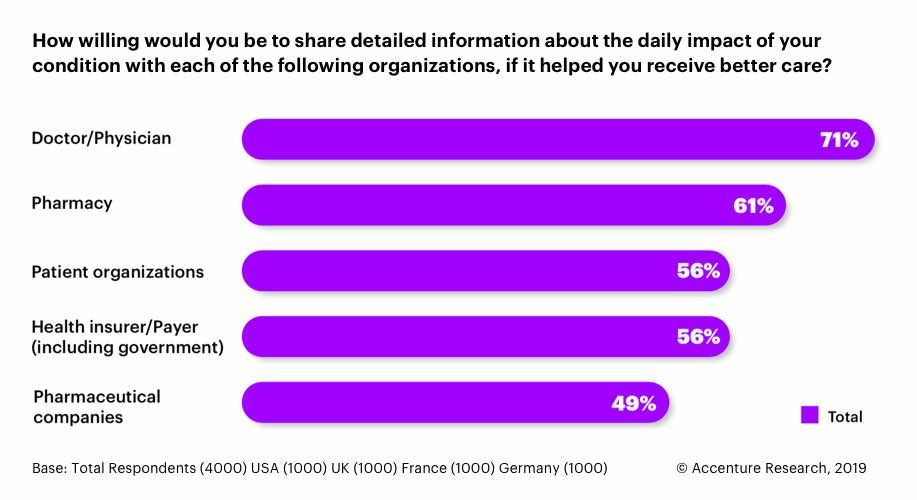Why pharma isn’t collaborating with patient organisations as much as it should

Patient centricity has rapidly gone from a fringe idea to a fundamental principle across the industry, but are pharma companies missing out on more impactful patient engagement through partnering with patient organisations?
This was the focus of a recent study from Accenture, which has suggested that pharma companies collaborating with patient support and advocacy groups could be key to delivering better experiences.
That may sound obvious, but the results of the Patient Services Study suggest that many patients don’t feel that pharma is doing this anywhere near as much as they should be.
The report surveyed 4,000 patients in the US and Europe, investigating the role that patient organisations play in providing support, information and other services to patients and whether better collaboration with pharma companies could improve the patient experience and care.
The study focused on three different medical conditions — migraine, rheumatoid arthritis and chronic lymphocytic leukemia — selected due to their significant, yet different, impact on patients’ daily lives.
The survey revealed that patients, regardless of their country or disease state, highly value services from patient groups and prefer them over those from pharmaceutical companies.
This holds true not only for emotional support and access to community support groups — services that patient organisations often provide — but also for information on therapies and clinical trials, which has more traditionally been provided by pharma companies.
Less than half (47%) of the surveyed patients said that pharma companies understand their emotional, financial and other needs related to their condition. In many ways that result is better than some might have expected given pharma’s historically chequered reputation among patients, but it is certainly disappointing when compared to other results from the survey showing that patients rate pharma companies lower on this than doctors/physicians, payers, pharmacies and patient organisations.
Yet despite these findings, most patients — 84% — believe that patient organisations should be working together with pharma companies to create a more seamless experience for them.
In fact, patients said that to improve their experience, it is more important that patient groups work together with pharma companies than with other healthcare players, including healthcare providers, payers and pharmacies.

They also said they would be willing to share more detailed information about the daily impact of their conditions if it helped them receive better treatment, and are much more likely to do so with patient organisations than pharma companies.
This, the report says, means that pharma cold gain easier access to patient insights and data by developing closer relationships with patient groups.
When asked why they chose to interact with their patient groups, patients said these organisations were easy to engage with, allowed them to engage with other patients in their situation, and that they had greater trust in the information being provided.
Perhaps unsurprisingly, patients are engaging with patient groups mostly via digital – with 88% saying they access content via the organisation’s website, and 78% receiving content via email.
But offline interactions are still holding their own in the digital world – 58% of patients say they attend in-person events hosted by the organisation, and 71% said they call the organisation to talk to someone, a result the authors of the study call “remarkable”.
Barriers to collaboration
Keena Patel, a managing director in Accenture’s Life Sciences Practice, says that the research shows a “critical need” for pharma companies to re-focus on what matters most to patients.
“To date, many pharmaceutical companies have focused on a limited set of data and results,” she says, “whereas our research shows that an overwhelming majority of patients want and need emotional support. They have a different set of criteria on what is a fulfilling experience.”
Patel notes that collaboration has often been slow to happen simply because patient centricity is still a relatively new concept to many pharma companies.
“At first, many approached it the same way they approached all their marketing activities; they tried to “own” the entire patient experience,” she says. “But managing health requires all parts of our healthcare system to work together, no one individually “owns” the patient or the patient’s experience.”
She adds that the role, influence, and reach of patient organisations has been growing; partly because patients need the engagement and value what these organisations provide.
“All parts of the ecosystem need to work together to help the average person find and navigate the support available, and patient organisations are front-line for patient support. We as an industry need to move away from an ownership mentality and focus on the best way to meet people where they are.
“It’s not a big hurdle for pharmaceutical companies to make some changes. For example, they could hire patients or caregivers to answer phones and provide welcome calls to other patients to help them onboard onto new therapies.”
Benefits to pharma
Among the top benefits that patients believe would result from a better level of collaboration between patient organisations and pharma companies are easier access to information on their condition and treatments (cited by 56% of respondents), easier access to treatment (56%) and more personalised care (54%).
The authors say that greater collaboration could also allow pharma companies to engage with patients much earlier in the treatment lifecycle – half of all patients surveyed said they engage with patient organisations before their treatment begins.
This would allow companies to gain a deeper understanding of patient’s individual needs through more personal and frequent engagement, they say, and provide a more “seamless” patient experience.
In fact, 37% of patients said that they believed pharma would better understand their needs if collaboration with patient organisations was improved.
“What if pharma shifted its view of patient organisations from a policy and advocacy standpoint and approached the relationship in terms of what they could collectively do to improve patient care and their health outcomes?” the report says. “Instead of thinking of limitations bound by regulatory, think of uncharted partnerships that use data, analytics, and real-life insights to create a care experiences that more precisely meet the needs of patients.
“In many cases, patient organisations play the unique role of aggregator of information, people and treatments. They are patients go-to, trusted place to get counsel about the realm of treatment and care possibilities and options.
“There is untapped opportunity for pharma companies to work with patient organisations to find unbiased areas that don’t involve a direct or implied endorsement. For example, exploring new ways to provide integrated services, clinical trial set up and recruitment, and services that address people’s non-clinical needs including the social determinants of health.”
The authors highlight two recent examples of initiatives like this. The first is Allergan’s collaboration with the American Migraine Foundation on interactive awareness campaign Frames of Mind, which aimed to promote awareness of the impact of migraines on people’s lives by asking patients to submit original artwork depicting how their symptoms affect them.
The second is UCB’s recent work with Parkinson’s UK on two patient engagement workshops looking at outcome measures and clinical trial design. The workshops found that while researchers had been looking at helping with tremor or bladder problems, what patients really wanted was help slowing down the progress of their disease.
“It is happening,” Patel concludes. “There are pharma organisations and patient organisations that are increasingly seeing the benefits of collaboration. If they reach out to patients and learn more about what they want and need, that can be the basis for developing future services. It is a win-win solution.”



